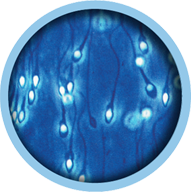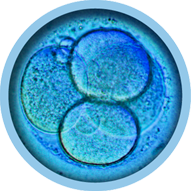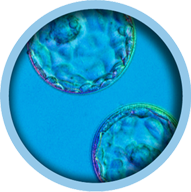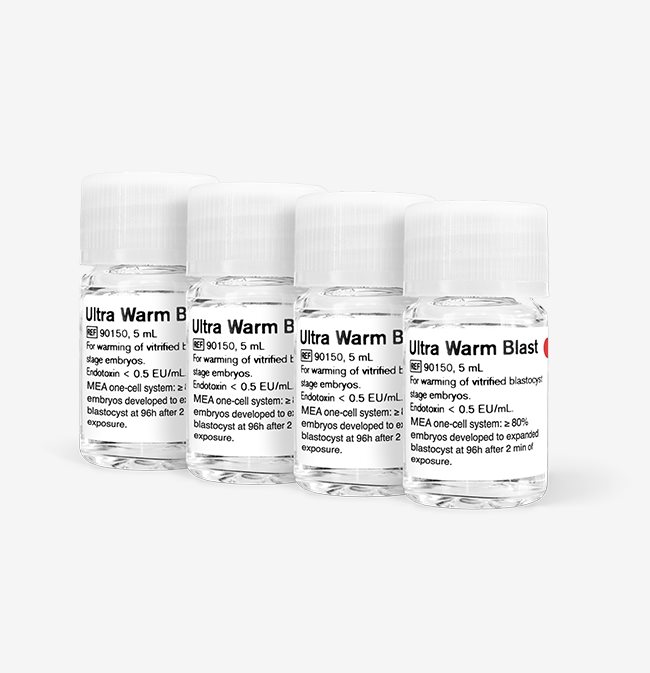
Ultra RapidWarm™ Blast
Maintain stable results in a fraction of your time.
Description A single medium for ultra-fast warming of vitrified human blastocyst-stage embryos.
Application Ready to use after warming to 37 °C in ambient atmosphere. Works with all cleared vitrification solutions and devices.
Storage Store dark at +2 to +8°C. Media bottles can be used for up to 2 weeks after first opening. Use aseptic technique and minimise the time outside the refrigerator.
Improve workflow without compromising clinical outcomes
While vitrification revolutionised embryo cryopreservation in IVF, it is still labour-intensive. Consequently, users have been seeking to streamline the workflow with a consistent, efficient procedure.
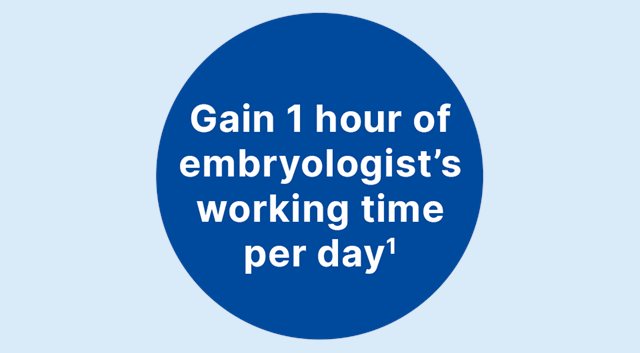
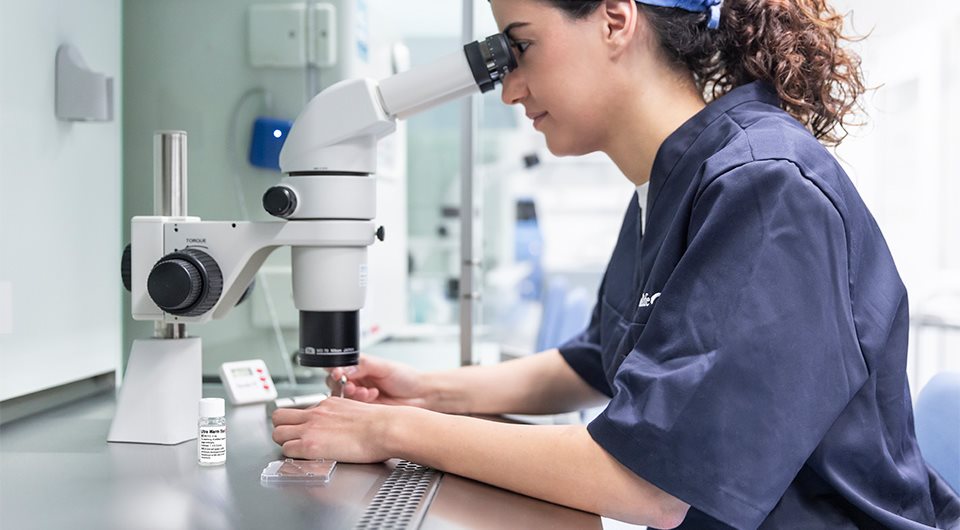
Ultra-fast warming of blastocysts
Recently, the golden standard of using a multi-step warming process has been challenged. Several publications have shown that blastocysts can be warmed in a much faster way, in just one warming step.
The studies demonstrate that single-step ultra-fast warming is comparable to multi-step standard warming in terms of survival, re-expansion and clinical outcomes, with the added benefit of saving time2,3,4.
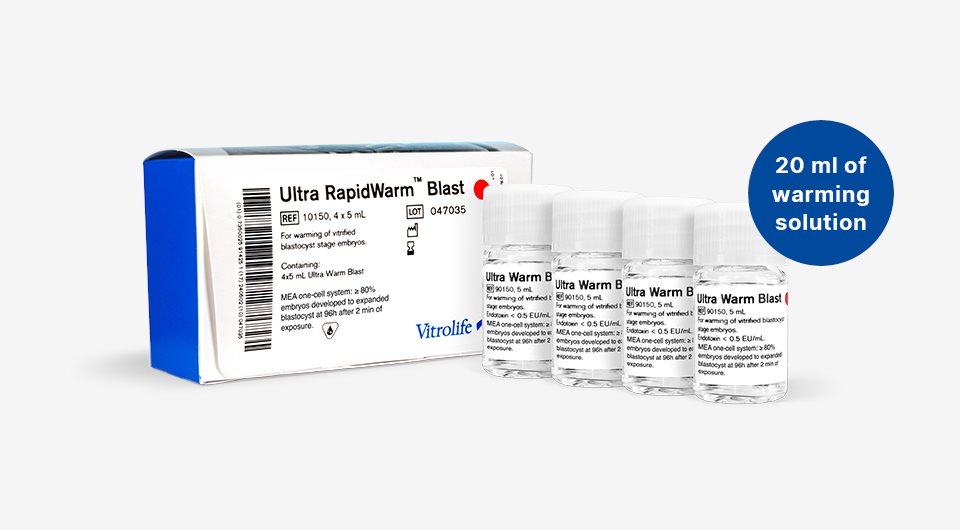
New product innovation with an ultra-fast warming protocol
Ultra RapidWarmTM Blast is a single medium used for warming of vitrified human blastocyst-stage embryos. The medium contains 0.25 M sucrose, and is supplied in four 5 ml bottles. Each bottle can be used for two weeks after first opening, if aseptic technique is used and time outside the refrigerator is minimised.
A game-changing warming procedure
→ Save 8-11 minutes per blastocyst5,6,7
→ Maintain safety and efficacy1,8,9
→ More robust protocol with reduced handling risk
→ Streamlined workflow with increased flexibility
→ Easy-to-train protocol

Clinical evidence
Several publications have shown that an ultra-fast warming protocol results in comparable embryology and clinical outcomes compared
with a conventional multi-step warming protocol.
Clinical results from studies showing a comparison of the ultra-fast warming protocol (0.25 M sucrose) with the standard warming protocol using Vitrolife warming media.
The studies demonstrate that warming of blastocysts with an ultra-fast 1-step warming protocol results in comparable clinical outcomes to the conventional 3-step warming protocol1,8.
Read the full study
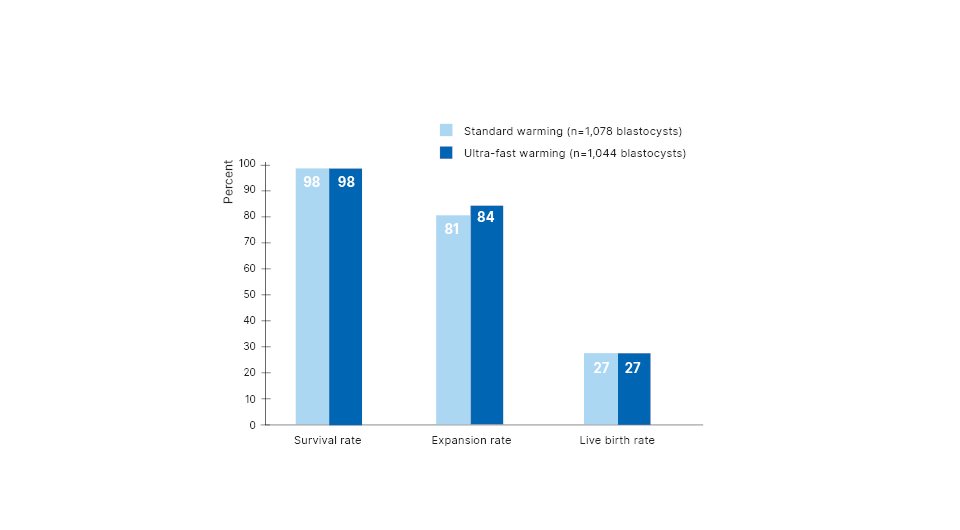
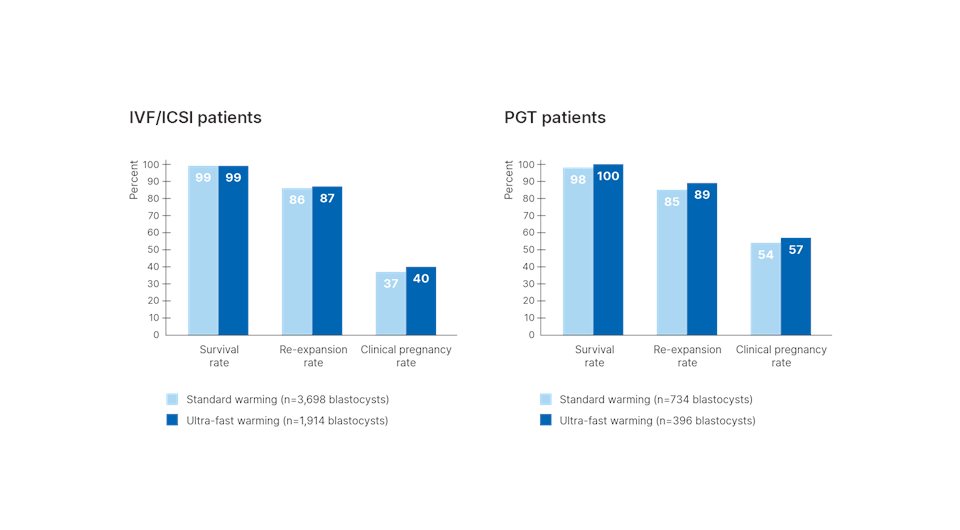
An analysis of retrospectively gathered clinical data comparing an ultra-fast warming protocol with the standard warming protocol for IVF/ICSI and PGT cycles. Blastocysts were vitrified using competitor media. Analysis shows that blastocyst survival rates, full re-expansion rates, and clinical pregnancy rates (based on fetal heartbeat) were similar between the ultra-fast and standard warming protocols in both patient groups9.
Read summary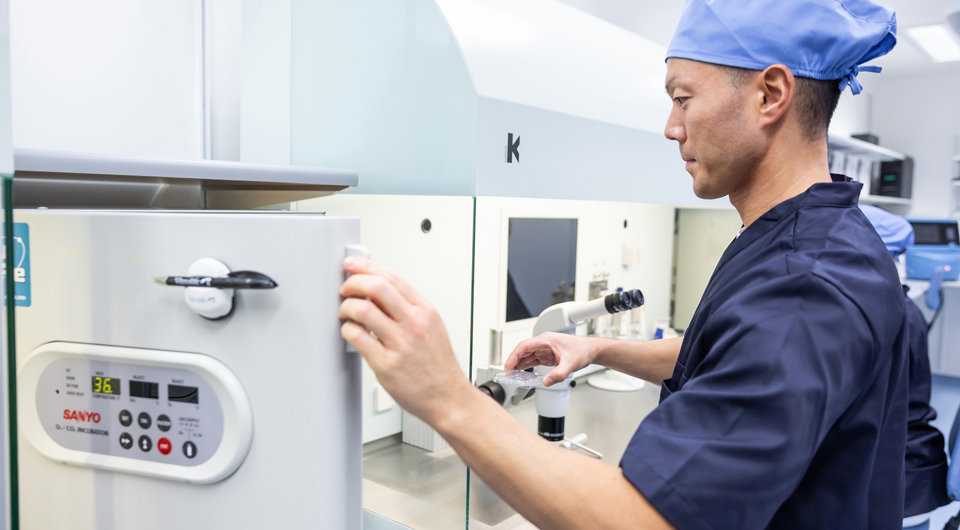
Ultra Rapid WarmBlast maintains embryo viability and appears to reduce stress
In the study by Okubo et al. warmed blastocysts using Ultra RapidWarm Blast was compared to conventional warming protocols. The blastocysts were vitrified in DMSO-media. The results showed that embryo survival, implantation and pregnancy rates were comparable between groups and that Ultra RapidWarm Blast significantly reduced blebbing incidence (5.1% vs. 10.9%; p<0.05), a marker of stress compared to conventional warming protocol. Ultra RapidWarm appears to effectively minimize cellular stress without affecting viability or clinical outcomes, compared to conventional warming protocols, suggesting it offers a safer, simpler alternative.
Read the full study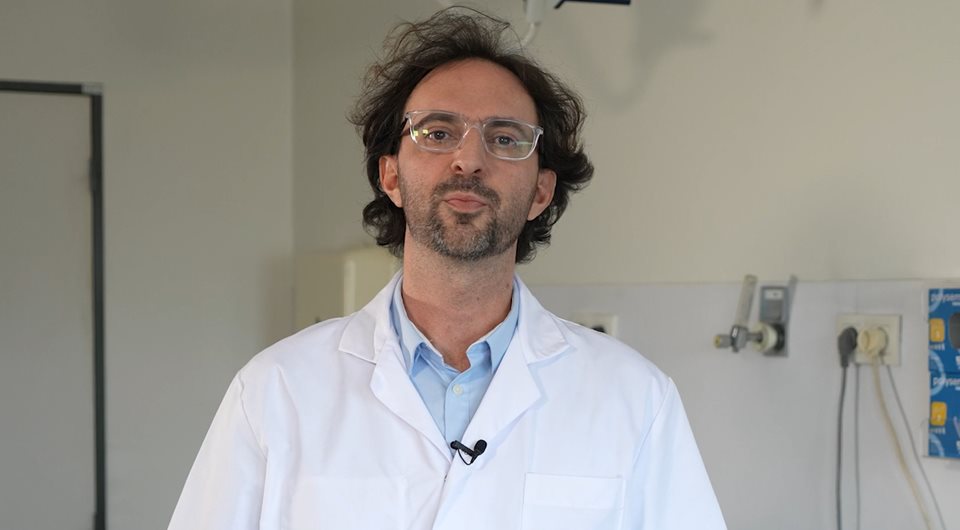
"..we moved from the conventional protocol to a new ultra fast warming protocol, which last 2 minutes instead of more than 10 minutes."
- Professor Thomas Freour, Chef de service - Biologie et Médecine de la Reproduction, gynécologie médicale Responsable du centre AMP, CHU de Nates
“Using an ultrafast blastocyst warming procedure results in similar embryology and clinical outcomes as compared to standard warming protocol. Lab’s work-flow was improved, as approximately 1 hour of embryologist’s working time was gained every day, resulting in increased productivity and flexibility for other tasks.
All members of staff reported feeling an improved quality of life at work with the implementation of this new protocol.“
- Professor Thomas Freour
Head of Infertility Department & ART Centre
University Hospital of Nantes, France
“We have seen clear benefits of a simplified warming protocol to save the time and labour required in the morning of ET day.
The HCG+ rates and GS+ rates after transferring those blastocysts warming in the ultrarapid protocol were comparable with the traditional method.”
- Tsuyoshi Okubo
IVF Lab Director
Shinbashi Yume Clinic, Japan
Low sucrose warming solutions reduce osmotic shock
Non-permeable cryoprotectants such as sucrose play an important role in the warming process by allowing elution of membrane-permeable cryoprotectants and gradual rehydration of cells.
Compared to the sucrose level in the vitrification solution, lower sucrose concentrations during warming reduce osmotic shock. Studies have shown that low sucrose solutions result in faster re-expansion and higher hatching rates compared to warming in higher sucrose solutions10,11
Re-expansion after warming is a key indicator of embryo viability and is positively correlated to pregnancy outcome12.
Additionally, faster re-expansion can streamline workflow and reduce waiting times for embryo transfer.
Blastocysts sink rather than float
When plunging the storage device in the warming solution, the blastocyst will either sink towards the bottom of the dish (in low sucrose solutions) or float to the surface (in high sucrose solutions) due to the differences in density between low and high sucrose solutions. Practically, using a low sucrose solution may result in a more standardised warming protocol with less risk of loosing visual control and exceeding the time in solution.
0.25 M sucrose
Density 1.03 g/cm3

1 M sucrose
Density 1.13 g/cm3

Optimised post-warming and transfer with hyaluronan
EmbryoGlue is a transfer medium, proven to significantly increase the clinical pregnancy rate, implantation rate and live birth rate14, also for vitrified blastocyst transfers in PGT cycles. A hyaluronan-enriched transfer medium, such as EmbryoGlue, has been recommended as an add-on by ESHRE since 2023.
Both EmbryoGlue and Ultra RapidWarm Blast contain high concentrations of hyaluronan. Scientific data has shown the importance of hyaluronan during embryo development and embryo implantation, but also to provide additional protection against cryodamage and to increase cryo survivability15,16,17,18.
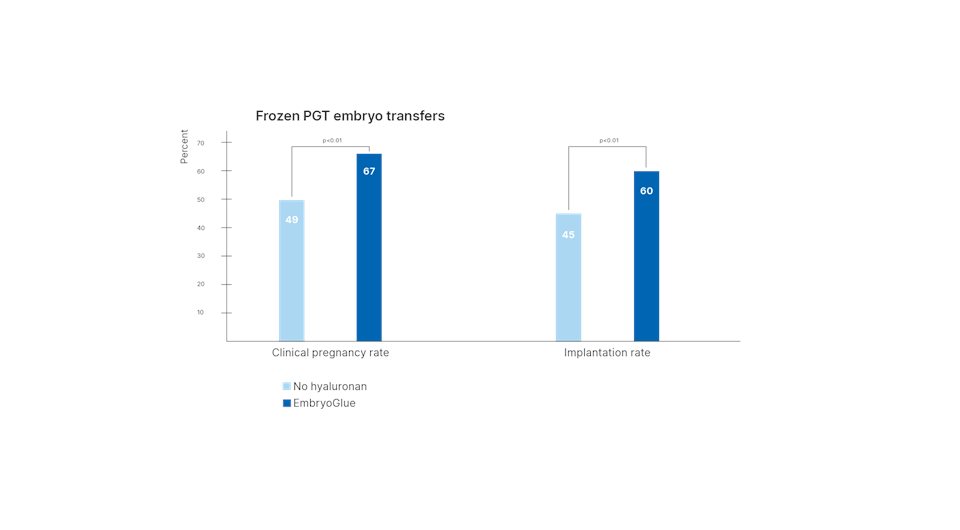
“Data on rapid warming of vitrified research blastocysts were promising and convinced us to perform a pilot study in 2023. We found that the time saving procedure also gave benefits with fewer steps, fewer manipulations and fewer handling risks. In addition, it is an operator friendly and simple protocol easy to train to other lab technicians.”
- Lisbet Van Landuyt
Senior Clinical Embryologist
Brussels IVF, Belgium
“I’m in! I couldn’t be happier with the product. It was a very easy roll in the fact that it is FDA-approved. The fact that there is a lot of clinical data on this made it for me very, very easy to implement.”
- Gerry Celia
Reproductive Laboratory Director
Offsite Director for the Women and Infants Hospital
Virginia Commonwealth University, USA
Top 5 reasons to choose Ultra RapidWarm Blast
- Works with all cleared vitrification solutions and devices
- Studies show faster re-expansion and higher hatching rates10,11
- Easy to use — blastocysts sink rather than float
- Cost-efficient packaging with 20 ml warming solution
- Industry-leading MEA
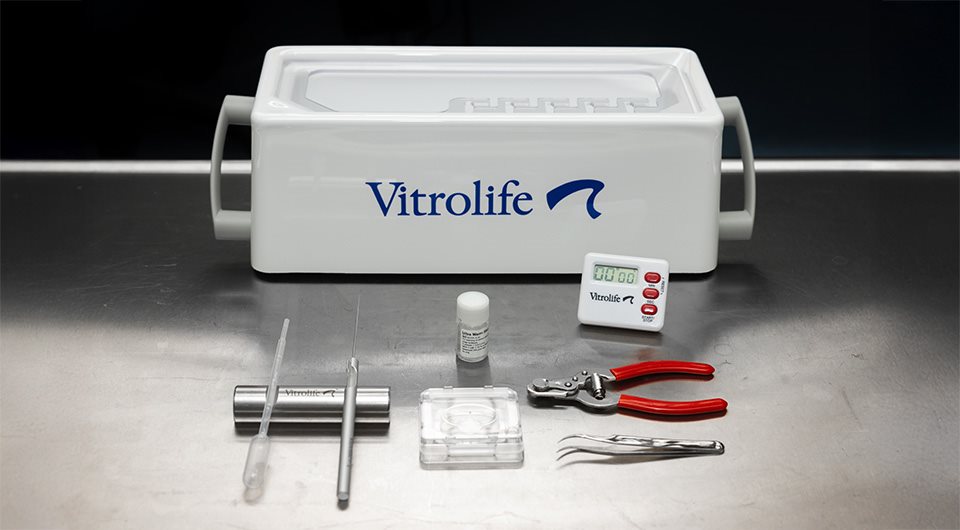
Webinar: 'Advancing blastocyst warming: The impact of Vitrolife’s ultra-fast protocol using low sucrose'
Discover the benefits of Vitrolife's ultra-fast warming protocol designed to save time and maintain consistent, high-quality results in the lab. This recorded webinar is ideal for clinical embryologists, reproductive specialists, and laboratory managers interested in innovative protocols to enhance efficiency and reliability in ART labs.
This live webinar was held in December 2024.
Watch webinar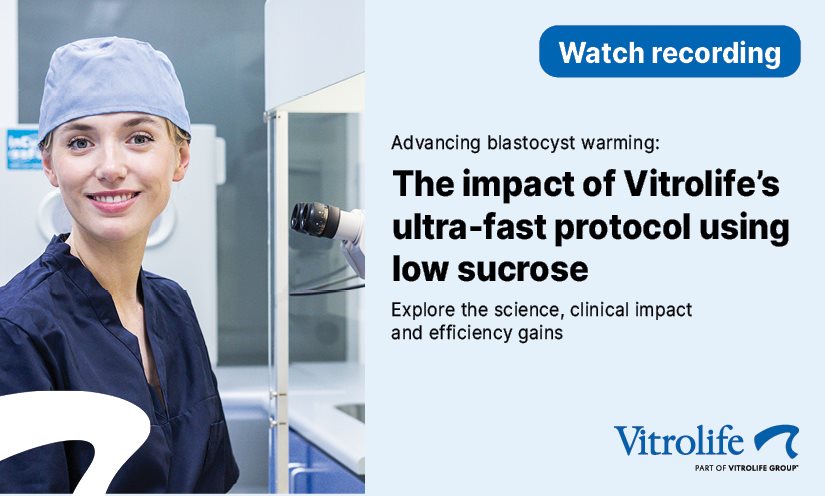
How to warm blastocysts with Ultra RapidWarm Blast
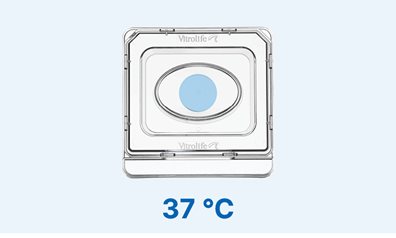
Preparation
Place at least 0.5 ml and up to 1 ml of warming solution into a dish and warm to 37 °C.

Warming
Leave the blastocyst in the solution for 2 minutes.

Post-warming
Wash the blastocyst several times with culture medium, or transfer medium such as EmbryoGlue®, then incubate until further use.
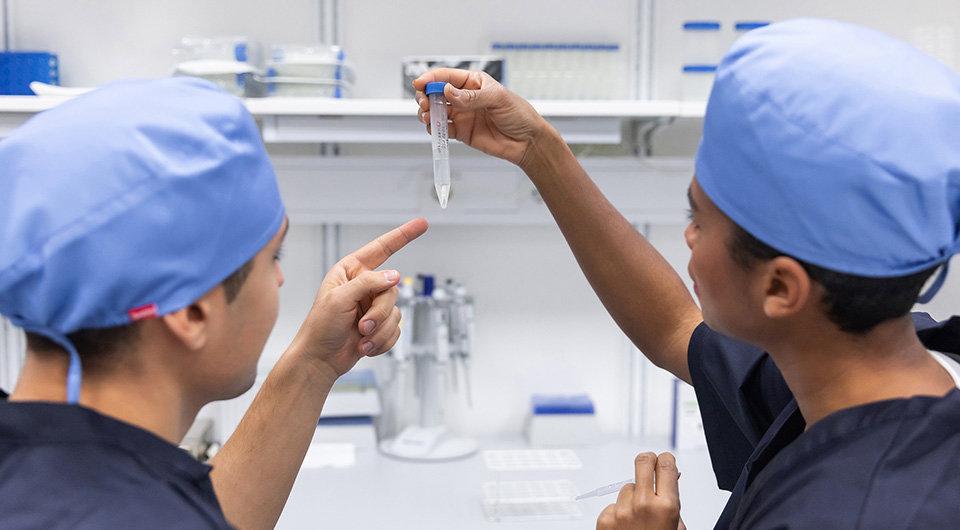
High lot-to-lot consistency ensures high performance
Vitrolife’s Mouse Embryo Assay (MEA) go beyond regulatory demands, using multiple endpoint assessments, including blastocyst cell number, with narrow acceptance levels to ensure high performance and the best results for the customers.
Vitrolife has unique competence in testing, which is performed in-house to maintain full control with traceability of each released product.
Learn more about qualityReferences
1. Freour et al., Quick as lightning, a French 12-month experience of ultrafast blastocyst warming on more than 1,000 single frozen-thawed blastocysts cycles, 2024, Fertility and SterilityVol. 122Issue 4Supplemente18.
2. Manns et al., Validation of a New Ultra-Fast Blastocyst Warming Technique Reduces Warming Times to 1 minute and Yields Similar Survival and Re Expansion Compared to Blastocysts Warmed Using a Standard Method. Fertility and SterilityVol. 116Issue 3Supplemente165, 2021.
3. Manns et al., 2022, Clinical validation of a new, ultrafast warming protocol, resulting in equivalent implantation rates and significant time savings versus routine warming protocol, a prospective randomized control. Fertility and Sterility 118(5):e7.
4. Taylor et al., Ultrafast warming protocol demonstrates similar outcomes and significantly decreases embryology workload compared to standard warming protocols, a randomized control trial with euploid blastocysts. Fertility and SterilityVol. 118Issue 4Supplemente150, 2022.
5. Package insert RapidWarm Blast REF 26086.
6. Package Insert Brand A.
7. Package Insert Brand B.
8. Lammers et al., Ultra-fast warming procedure of vitrified blastocysts results in maintained embryology and clinical outcomes, Reprod Sci. 2025 Feb;32(2):495-501
9. Van Landuyt et al., FC-07 Results after 6 months of clinical use of a short one-step warming protocol for vitrified blastocysts, 52nd BSRM Scientific Meeting 2024.
10. Gunst & Ahlström, Multicenter preclinical validation of warming procedures for human blastocysts involving a short exposure to a single sucrose solution shows promising survival, re-expansion and continued development, BSRM 2022.
11. Liebermann et al., Rapid warming of human blastocysts: Is 1M sucrose the only choice? 65th AAB Conference 2023.
12. Yoneyama et al., 2025, Blastocyst re-expansion rate immediately after warming is a strong dynamic indicator of embryo quality, Reprod. BioMedicine Online, In press.
13. Vitrolife data on file 2025.
14. Heymann et al., Cochrane Database Syst Rev. 2020 Sep 2;9(9):CD007421.
15. Gardner et al., (1999) Hum. Reprod. 14, 2575-80.
16. Stojkovic et al., (2002) Reproduction 124, 141-53.
17. Lane et al., (2003) Mol. Reprod. Dev. 64, 70-8.
18. Palasz et al., (2006) Mol. Reprod. Dev. 73, 1503 .
19. Reed M et al., (2022) Fert. Stert. Volume 118, Issue 5, Supplement e46-e47.
Support Documents
Documents Language

SSCP
English
SSCP Ultra RapidWarm Blast
Document and Ref: REP-6458. Version 5.0. 2025/04/10

Safety data sheets (SDS)
English
SDS Ultra RapidWarm Blast
Document and Ref: Document and Ref: Date Revised : 04/16/2025.Revision No : 2. Safety data sheet for Ultra RapidWarm Blast

Short protocols
English
Warming of blastocysts using Ultra RapidWarm Blast
Document and Ref: REF 19603. Version 02. Date of issue 241010. This short protocol describes how to warm blastocysts using Ultra RapidWarm Blast.

Package inserts
English
Package insert Ultra RapidWarm Blast 10160 - Multi-language
Document and Ref: REF 28355, Version 02. Date of issue: 20250613

Package inserts
English
Package insert Ultra RapidWarm Blast 10150 - US version
Document and Ref: REF 28351, Version 04. Date of issue: 20241203
Do you have a question about this product?
Contact us
Find your local Vitrolife representative
Contact usMaximise success every step of the way
We provide what you need to secure improved results throughout the IVF journey.

